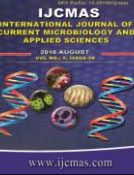


 National Academy of Agricultural Sciences (NAAS)
National Academy of Agricultural Sciences (NAAS)

|
PRINT ISSN : 2319-7692
Online ISSN : 2319-7706 Issues : 12 per year Publisher : Excellent Publishers Email : editorijcmas@gmail.com / submit@ijcmas.com Editor-in-chief: Dr.M.Prakash Index Copernicus ICV 2018: 95.39 NAAS RATING 2020: 5.38 |
Biofouling is a process of attachment and growth of micro- and macro-foulers on submerged natural or manmade marine structures causing huge economic and environmental losses worldwide. Marine organisms are rich source of structurally novel and biologically active metabolites and can be one of the best replacement options as natural antifoulants against toxic heavy-metal-based paints. Mangroves possess a diverse array of bioactive compounds; hence, an attempt was done to evaluate its antifouling (AF) potential. In this study, a biofoulant sample was collected from boats, and culturable marine bacteria were isolated on Zobell’s marine agar medium. The 16SrRNA sequencing of five isolates was done and confirmed to be Vibrio parahemolyticus, Vibrio nereis, Micrococcus luteus, Exiguobacterium profundum and Salinicocoocu shispanicus. In vitro screening for AF potential of methanolic extract of two mangroves(leaves, bark and root), viz. Bruguiera cylindrica and Rhizophora apiculata collected from Pichavaram against biofouling bacteria was done by the agar diffusion method. The results indicated that mangroves have potent AF components and can be used as a natural source of antifoulant.
 |
 |
 |
 |
 |